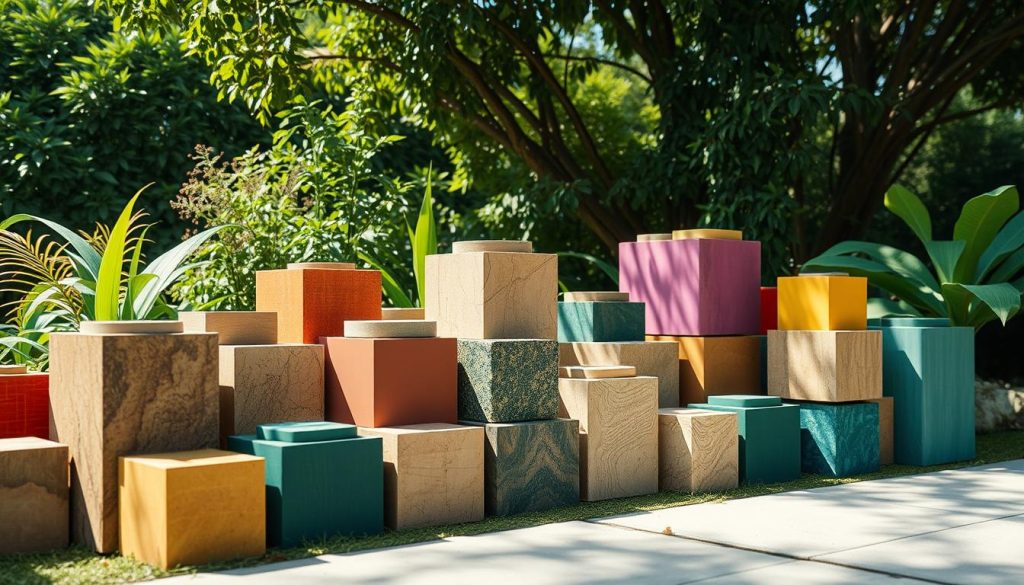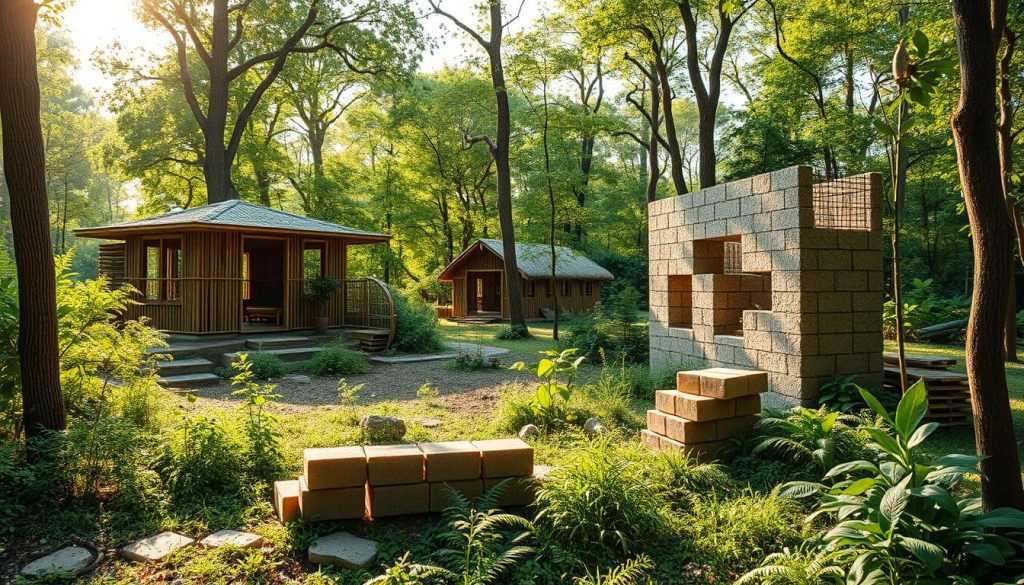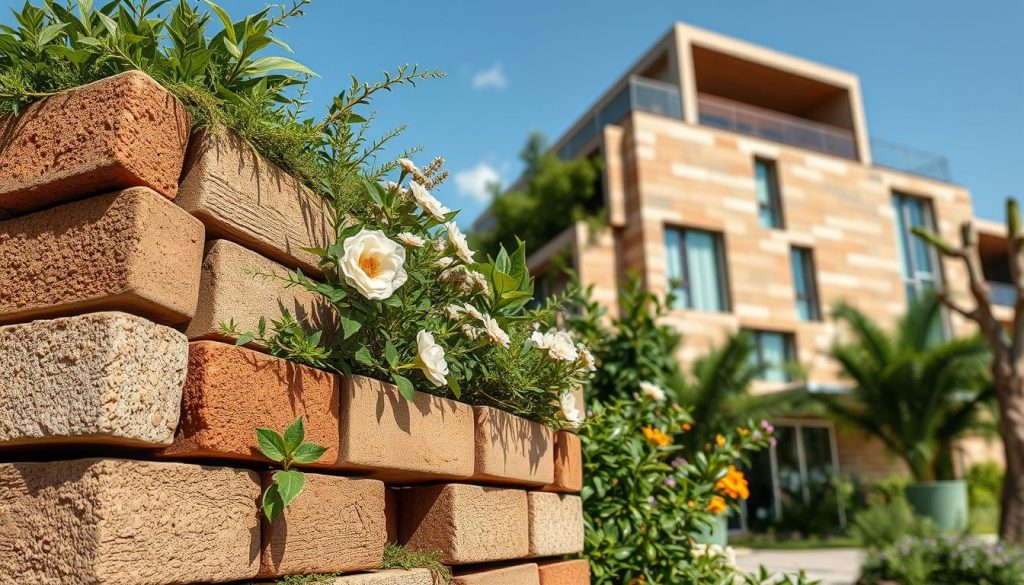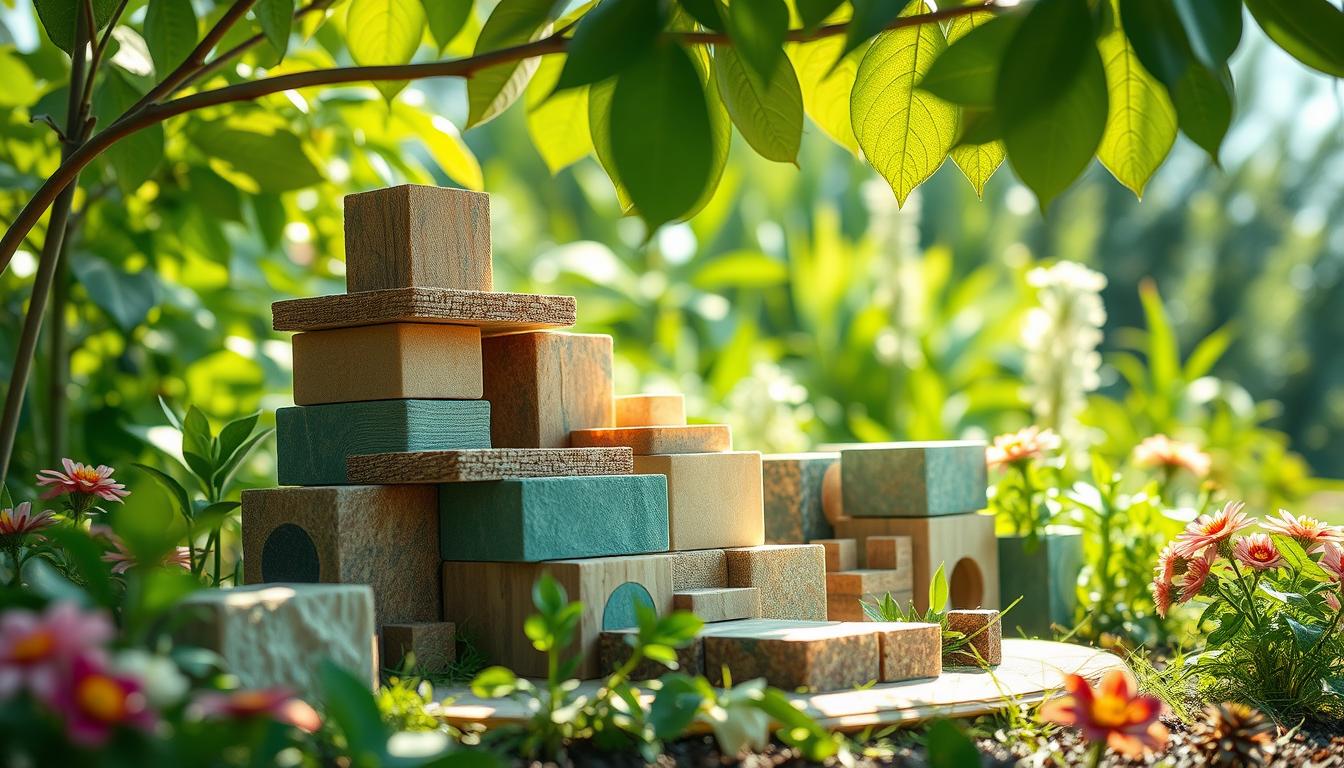Exploring sustainable construction, the role of eco-friendly building blocks is huge. These materials are changing how we build, making structures both useful and green. By choosing these materials, we cut down on pollution and improve living spaces for everyone.
Studies reveal that green building products reduce waste and boost health. In our quest for greener homes, eco-friendly blocks stand out. They meet our environmental goals and the demands of today’s building projects.
The Importance of Sustainable Construction Materials
Choosing sustainable construction materials is key for today’s buildings. The push for eco-friendly options comes from wanting to save our planet. As people want greener choices and rules get stricter, builders are going green too.
These materials help save natural resources, support wildlife, and cut down on harmful emissions.
Why Choose Eco-Friendly Options?
There are many good reasons to choose eco-friendly materials. First, they often come from sources that can be replenished, which is better for the environment. Also, many companies focus on being good to the planet, which affects construction choices.
Using sustainable materials shows a commitment to a healthier world for all.
Benefits for the Environment and Health
Using sustainable materials has two big advantages. They help protect our planet and make buildings healthier for people inside. These materials can reduce harmful air inside buildings, making them better for our health.
Research shows that green buildings are not just good for us but also for the environment.
| Type of Material | Environmental Benefit | Health Benefit |
|---|---|---|
| Recycled Steel | Reduces waste and energy usage | Minimizes toxic emissions |
| Bamboo | Fast-growing, renewable resource | Non-toxic and hypoallergenic |
| Straw Bales | Biodegradable and insulating | Improves indoor air quality |
| Reclaimed Wood | Prevents deforestation | Unique aesthetics, promotes well-being |
Eco-Friendly Building Blocks: A Greener Choice

Understanding eco-friendly building blocks is key in today’s building world. These blocks are made from materials that are good for the planet. They use things like reclaimed wood, recycled plastics, and local materials.
These products are as good as, or even better than, traditional materials. They show how we can build in a way that’s kinder to our planet.
What Are Eco-Friendly Building Blocks?
Eco-friendly building blocks are a step towards better building practices. They’re made with care for the earth, using materials that are gentler on the environment. Using these blocks shows a commitment to being green, attracting both builders and homeowners who care about the planet.
Types of Eco-Conscious Building Materials
There are many eco-friendly building materials out there. Here are some:
- Natural insulation materials: These are made from cotton, wool, or cellulose. They keep buildings warm and are safe for people and the planet.
- Low-emission paints: These paints have fewer harmful chemicals. They help keep the air inside buildings clean.
- Bamboo products: Bamboo grows fast and is a great choice for floors and cabinets.
- Innovative options like hempcrete and rammed earth: These materials use unique methods to build. They’re all about being sustainable and using resources wisely.
As more people learn about the benefits of eco-friendly choices, there are now certifications for these materials. These certifications mean the materials meet high environmental standards. They help make building greener and more sustainable.
Exploring Green Building Products

Green building products are becoming key in construction as we seek sustainable structures. New technologies are changing how we build green. They help cut down waste, use less energy, and make us more eco-friendly.
Innovative Technologies in Green Construction
New tech is boosting green building. For instance, 3D printing makes eco-friendly building blocks quickly. This cuts down on waste and lowers carbon emissions.
Smart building tech, like energy-saving systems, also plays a big role. It helps us use less non-renewable energy. This leads to a greener future.
Top Brands Leading the Way
Many top brands are leading in eco-friendly materials. Companies like EcoBlocks, Green Building Supply, and Habitat for Humanity’s EcoBuilding program are leading the charge. They offer products that help the environment and make buildings more resilient.
Their success encourages builders and consumers to choose green materials for their projects. It’s a step towards a more sustainable world.
Understanding Environmentally Friendly Bricks

Understanding eco-friendly bricks is key to sustainable construction. They are a better choice than traditional materials. They use local resources, cutting down on carbon emissions while keeping buildings strong.
These bricks are made from fly ash, recycled concrete, and soil-stabilized earth. Each material helps make the bricks durable and good for the planet.
Materials Used in Eco-Friendly Bricks
Eco-friendly bricks are made with special materials. Fly ash, from coal burning, adds strength and recycles waste. Recycled concrete uses old building materials, saving new resources.
Soil-stabilized earth bricks use local soil. This makes them efficient and supports local economies.
Comparing Traditional vs. Eco-Friendly Bricks
Comparing traditional and eco-friendly bricks shows their differences. Eco-friendly bricks need less energy to make and have lower emissions. They are often made locally, which is better for the environment.
Here’s a table that shows these differences:
| Feature | Traditional Bricks | Eco-Friendly Bricks |
|---|---|---|
| Energy Consumption | High | Low |
| Environmental Impact | Higher emissions | Reduced emissions |
| Resource Use | New materials | Recycled/local materials |
| Lifespan | Long-lasting | Equally durable |
Exploring eco-friendly bricks, I found many benefits. Builders are switching to them for their long life and green benefits.
Green Construction Blocks for Various Projects
Green construction blocks are great for many building needs. They work well in both homes and businesses. These blocks make buildings look good and work well, fitting all kinds of designs.
Residential vs. Commercial Applications
When building, homes and businesses have different needs. Green construction blocks meet these needs in:
- Residential homes, where energy efficiency and looks matter.
- Commercial spaces, needing to last long and be easy to care for.
Both homes and businesses gain from these blocks’ eco-friendly nature. This meets strict environmental rules and people’s desire for green choices.
Durability and Lifespan of Green Construction Blocks
Green construction blocks last a long time. Studies show they often beat regular materials. Key benefits include:
| Material Type | Durability Rating | Lifespan (Years) |
|---|---|---|
| Green Construction Blocks | High | 50+ |
| Traditional Concrete | Moderate | 30-50 |
These blocks last longer than usual materials. This means they cost less over time and are better for the planet. Their lasting quality and green benefits make them a smart pick for any project.
Application and Availability of Sustainable Building Materials
In today’s world, I’m excited to see how advancements in supply chain logistics have transformed the application of sustainable building materials. Now, we don’t have to search far and wide for eco-friendly options. They are increasingly accessible to builders and DIY enthusiasts alike.
This shift makes it easy to find these materials. It also encourages more people to adopt environmentally conscious practices in their construction projects.
With a growing number of local suppliers and online platforms dedicated to providing sustainable building materials, the options for sourcing these eco-friendly materials have expanded significantly. I find it refreshing that I can now browse through various products from the comfort of my home or visit nearby stores to pick up what I need.
This availability of eco-friendly options empowers individuals like me to make smarter, greener choices when it comes to construction.
Moreover, as more manufacturers commit to sustainability, I notice an increasing variety of products on the market, catering to different needs and preferences. This evolution not only simplifies the procurement process but also fosters a greater awareness of the importance of using sustainable materials in our projects.
It’s an exciting time to be involved in construction, and I’m eager to embrace the benefits of these innovative solutions.

